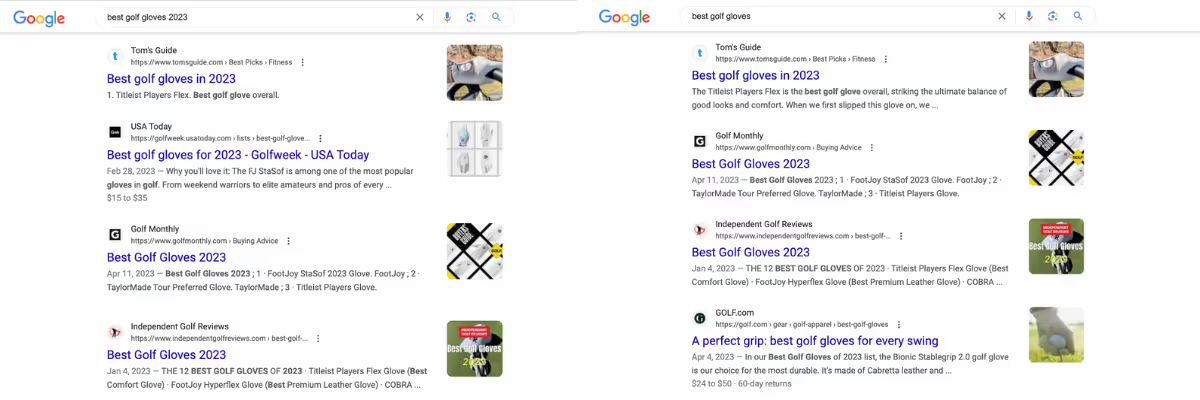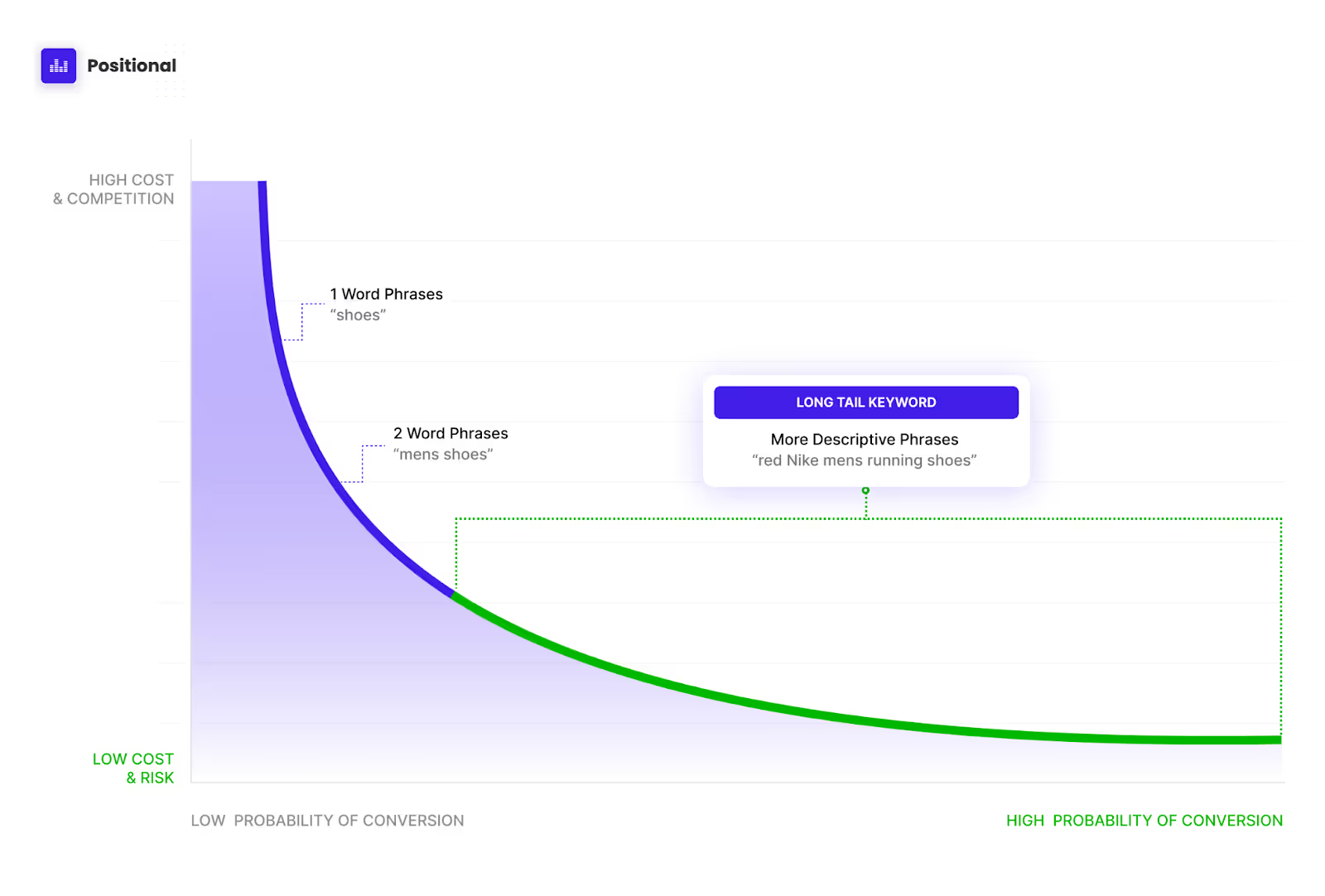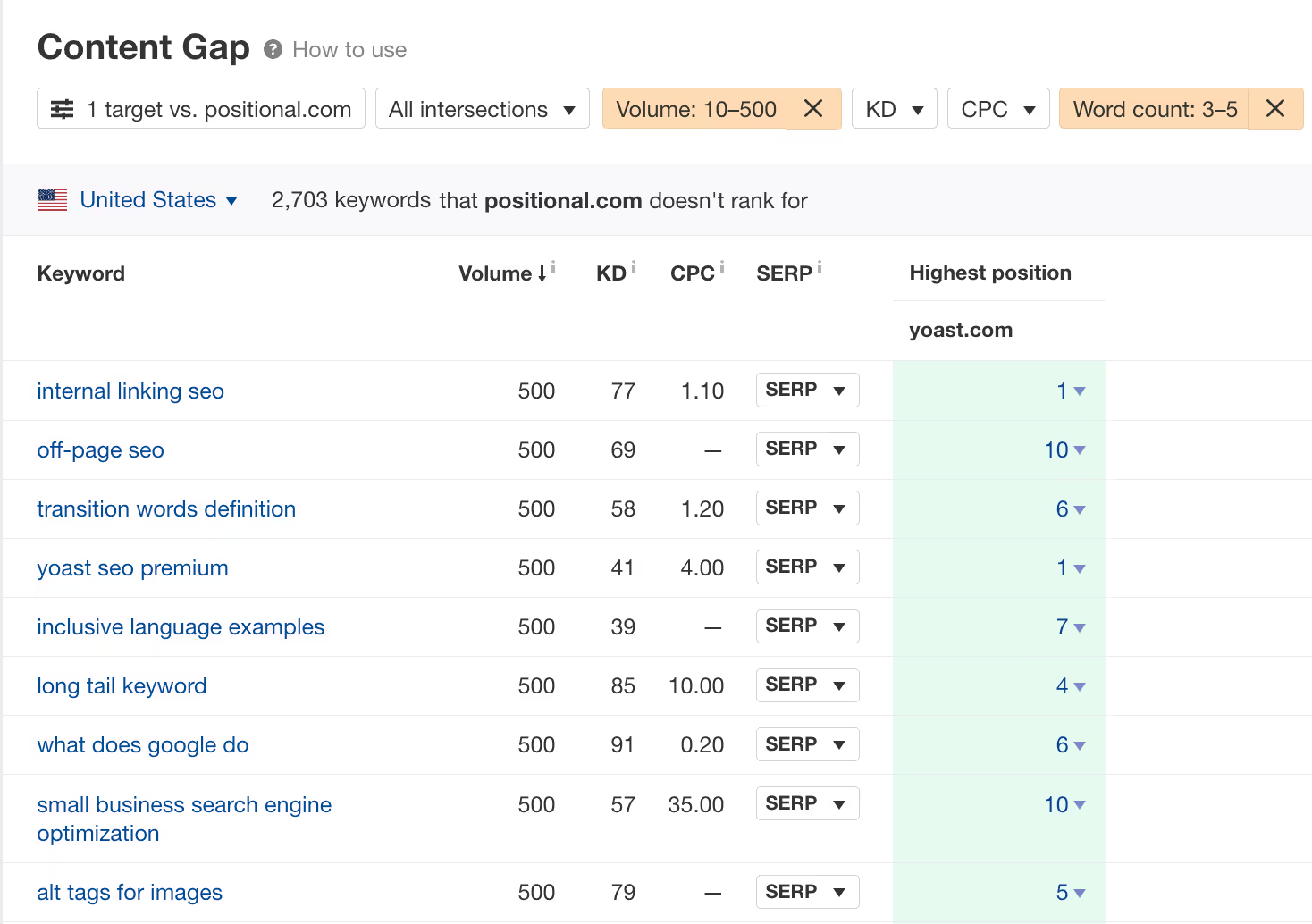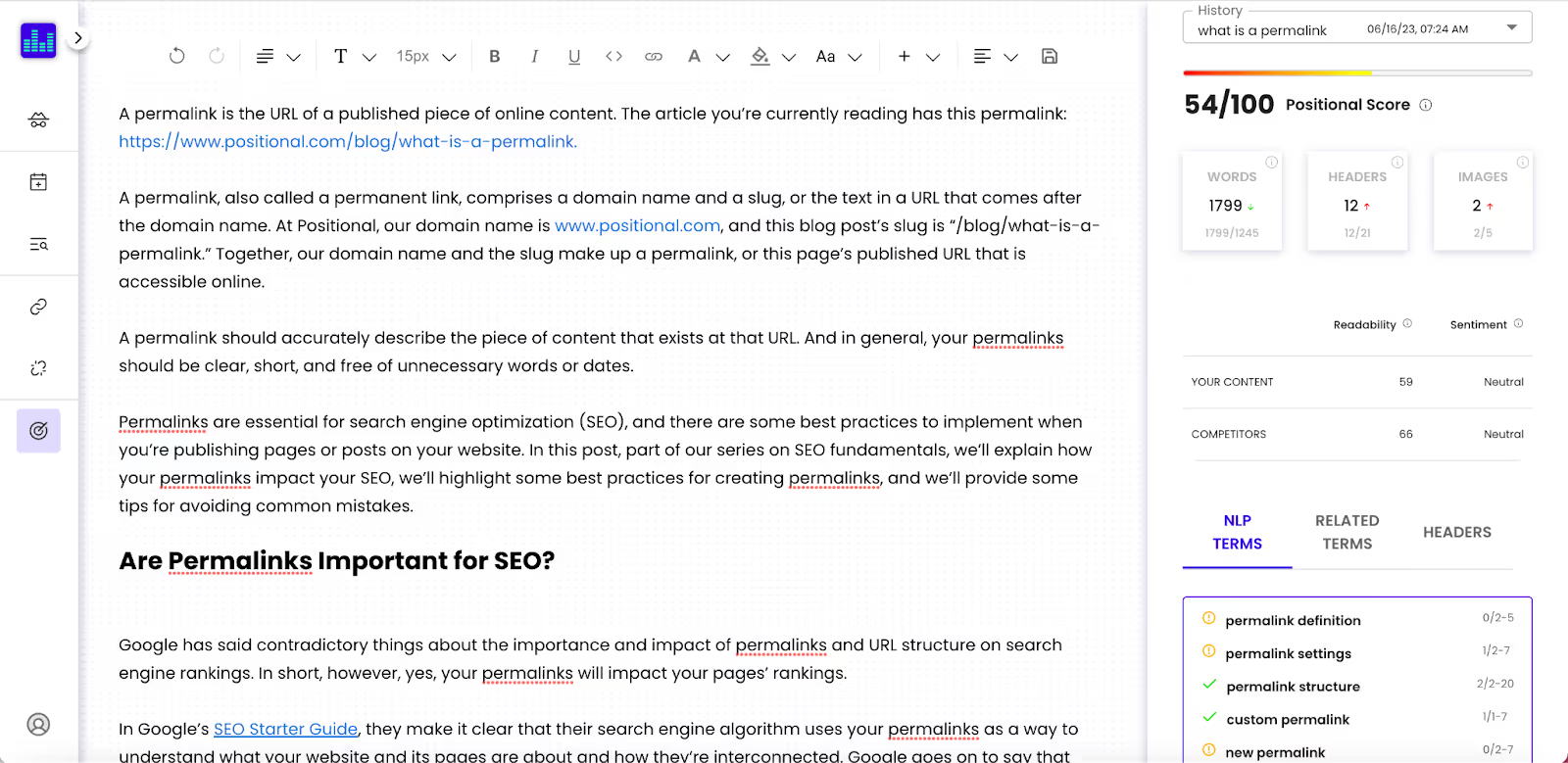You absolutely need to be thinking about the role of long-tail keywords in your content marketing and search engine optimization (SEO) strategy. According to a 2021 report from Ahrefs, 95% of all keywords get ten or fewer searches per month — in other words, they’re long-tail keywords, which can be easier to rank for in many industries.
Long-tail keywords are more specific or longer variations of head terms (also known as short-tail keywords). They can be supporting, in pieces of content that are primarily targeting head terms, and they can be topical, in standalone pieces of content created to rank for a very specific search intent.
For example, if I were building a webpage targeting the keyword “cheap car insurance,” supporting long-tail keywords might include terms like “best cheap car insurance companies,” and I’d want to incorporate those terms in my piece of content. But I might also decide that another long-tail keyword — for instance, “car insurance discounts for seniors” — was deserving of a standalone webpage.
But how should you include and prioritize long-tail keywords in your content calendar? And how can you optimize for longer-tail keywords in the content you’re already writing?
In this guide, we’ll dive deep into all things related to long-tail keywords. We’ll go into their importance, define the two different types, show you how to find them, and explain how you can optimize your content for them during the content creation or editing process.
Long-Tail Keywords vs. Head Terms
There are two types of keywords: head-term keywords and long-tail keywords.
A head term is typically defined as a keyword composed of one to three words that cover a broad topic. A long-tail keyword is more specific and usually contains three to five words but can sometimes be longer, depending on its niche.
Long-tail keywords typically have lower search volume than head terms. When you’re doing keyword research, you’ll notice that long-tail keywords tend to be less competitive and have lower keyword difficulty scores.
There are also two distinct types of long-tail keywords: supporting long-tail keywords and topical long-tail keywords: the first type is used to attack less popular variations of head terms, and the second type is used to rank for unique and very specific intents. More on this later!
For example, when searching for a head keyword like “car insurance,” a related and topical longer-tail keyword might be “cheapest car insurance in California.”

Head terms typically have higher search volume, which means they are often more competitive. With many head terms, the intent of the searcher might be unknown. And since Google doesn’t know the searcher’s exact intent, they’ll provide a mix of different results for more specific intents.
With long-tail keywords, the searcher usually has a much better idea of what exactly they’re looking for. It’s often much easier to rank for long-tail keywords with very targeted pieces of content than to rank for all of a category’s keywords with a broader mega-guide or pillar post. And that just makes sense: Google wants to provide the most relevant results to answer searchers’ questions.
When you’re crafting a content strategy, you want to build content for both head terms and long-tail keywords. You can create standalone pieces of content that are meant to rank for long-tail keywords, and you can also incorporate long-tail keywords, or related keywords, into the posts you’re already writing. In the next section, we’re going to dive a bit deeper into the two distinct types of long-tail keywords.
Examples of Long-Tail Keywords | 2 Types
As part of your content strategy, you should incorporate two different types of long-tail keywords. Some long-tail keywords represent a lower search volume alternative to a head term. Others are unique and require a standalone piece of content or webpage.
Supporting long-tail keywords are closely related variants of a primary keyword. Topical long-tail keywords are very specific keywords that are not closely related to a primary keyword, and that have low search volume and specific search intents.
If you’re ever confused about whether a keyword is supporting or topical, you should look to search engine results pages (SERPs) to see what’s already ranking for a given term. If you search for a variant of a primary keyword, and the results are nearly identical to what’s already ranking for the primary keyword, the variant is a supporting long-tail keyword. However, if the results are very different or a lot more specific to that variant, it’s a topical long-tail keyword that probably merits a standalone page on your website.
Whenever I’m doing keyword research for a new website, I’ll first generate a list of the keywords we should be targeting and each keyword’s search volume. Next, I’ll combine supporting keywords into groups and split out topical keywords into standalone items in my editorial calendar.
Supporting Long-Tail Keywords Example
For example, if we were building a webpage targeting the keyword “best golf gloves” (search volume: 4,400 per month) and, during our keyword research process, discovered that “best golf gloves 2023” (search volume: 440 per month) was a longer-tail keyword for us to consider, we might be confused as to whether it was a supporting long-tail keyword that we should include in our article targeting “best golf gloves” or a topical long-tail keyword that we should target with a standalone article on our website.
In this example, “best golf gloves 2023” is a supporting long-tail keyword and should be included in our more general piece.
Why? Well, if you look at the search results for each of these keywords, the results are nearly identical, with three out of the top four results being the same for each search.

Topical Long-Tail Keywords Example
However, during our keyword research process, we also identified the keyword “best golf gloves for sweaty hands” (search volume: 480 per month). It’s closely related to the head term, “best golf gloves,” but it’s a topical long-tail keyword and should be split out into a standalone piece of content.
Why? Well, if you look at the search results, the results are completely different. The top five articles ranking for the keyword “best golf gloves for sweaty hands” are very specific to this variation and search intent.

We could certainly mention golf gloves that are good for sweaty hands in our more general post about the best golf gloves, but we would want to internally link over to our more specific post on the topic.
As we discuss later in this article, your more specific post for this topical long-tail keyword will rank better in search and likely have a much higher conversion rate, too.
6 Reasons to Use Long-Tail Keywords
Both supporting and topical long-tail keywords are critically important to any content marketing strategy.
They’re Easier to Rank For, and They Drive Incremental Traffic
Whether you’re optimizing for supporting long-tail keywords or building standalone pieces of content for topical long tails, they’re going to be easier to rank for, and you’ll be able to drive traffic faster.
For any new site or category expansion, I’d prioritize lower- to medium-difficulty keywords first to drive initial traffic, and long tails are great for doing just that. You can then layer in the more difficult and higher-volume keywords as you build topical relevance and domain authority.
The Importance of Supporting Long-Tail Keywords
Supporting long tails can help a piece of content rank better for less popular but closely related variants of the primary keyword. They’re important in a number of ways.
Showing Google Your Article Is Complete
In SEO circles, it’s understood that Google often knows what a piece of high-quality content should look like. That’s why you’ll frequently find that the results on the first page of a Google SERP look pretty similar. Especially for websites in a YMYL (Your Money or Your Life) category, like consumer finance or health care, you’ll want to align your pieces of content to what is already ranking well in search.
Used correctly, long-tail keywords help to show Google that your article is complete and helpful for a searcher. You can very actively attempt to optimize your content with long tails that your competitors are using in their content as a way to show Google that your piece is of high quality. And in the process, you’re likely going to make your article more helpful.
There are tools for doing this in a data-driven way, and we highlight one such tool for you later in this article.
Ranking for a Larger Number of Keywords
By incorporating supporting long tails into your content, you’ll find that your articles will end up ranking for additional keywords.
And that makes sense. As people search for slightly different but closely related versions of the primary keyword, the long-tail keywords that you include in a piece of content will signal to Google that the piece should rank for those terms.
The Importance of Topical Long-Tail Keywords
Topical long-tail keywords are unique enough that they require a standalone webpage and typically target a very specific search intent. They’re important in a number of ways.
Building Topical Authority
You’ll often hear the terms “topical authority” and “topical relevance.” They’re used to describe how Google views your website and which topics it considers your website to be a good source of information on.
As part of building topical authority or showing Google that your website is a good resource on a particular topic, you’ll want to build out a portfolio of content targeting the topical long tails within your niche. I firmly believe that to be seen by Google as the best source of information within a niche, you must attack all of the keywords within that category, both head terms and long tails. Depending on the niche you’re building in, you might find that your readers or prospective customers have a large number of very targeted questions — and as a result, there may be a large number of long-tail keywords.
As mentioned previously, a topical long-tail keyword is one that you’ll want to create a standalone blog post or webpage for. By covering the spectrum of these topical long-tail keywords and by correctly internally linking throughout your website, you can strengthen your topical authority or relevance for Google. This will lead to improved rankings for existing content and faster rankings for the new pieces of content you publish.
Ranking Better for Specific Intents
Topical long-tail keywords are often targeting a very specific search intent that doesn’t align directly with a head term.
It used to be the case that you could rank one very large mega guide for a large number of keywords and for different search intents. But today, Google is prioritizing content focused on very specific keywords or intents. And that just makes sense. The more directly helpful a piece of content is, the better the searcher’s experience is.
If you’re targeting several topical long-tail keywords, you’ll find that multiple very targeted pieces of content will perform much better than one more general piece of content.
When in doubt, split the long-tail keyword out into a standalone piece of content focused on that specific search intent. Your rankings will thank you.
Higher Conversion Rates
You’ll typically find that the more specific you can get with a piece of content, the higher the conversion rate will be. For transactional keywords, long-tail variants will have higher conversion rates than more general head terms or terms where the search intent is unclear.
For example, if your website is selling shoes, you could, in theory, rank with a general page about the many different types of shoes you sell, but the conversion rate for that page is likely going to be low. A better approach is to create a large number of standalone pages that target the specific intents that searchers may have.

For example, a webpage about red Nike men’s running shoes is going to have a much higher conversion rate for shoppers looking to purchase that kind of shoe than a more general piece of content. This page will also likely rank much better for the topical long-tail keywords in view, in this case, the long-tail keywords related to “Nike,” “red,” and “running.”
These very specific keywords or pages are going to drive less traffic on an individual basis, but don’t be surprised if you see much stronger performance from a conversion standpoint.
How to Find Long-Tail Keywords
There are a number of different ways to find long-tail keywords. Here, we’ll highlight four methods.
Think Critically About the Questions Your Customers Have
When you’re first starting your content marketing strategy, your first thought might be to turn to a keyword research tool like Ahrefs, Semrush, Google Keyword Planner, or Positional. While these tools are fantastic for companies in popular industries, the datasets are often less helpful for companies in new or niche industries — for example, developer tools.
Even before using a toolset for keyword research, you should think critically about the questions and perspectives you’re hearing from your customers. And if you have extensive domain expertise in your industry, you likely know what very specific questions your target customers have.
When thinking about attacking topical long-tail keywords or creating very specific pieces of content, you should first start with those customer questions. If possible, it’s great to use a keyword research tool to validate your assumption with data, but sometimes that isn’t always possible, given the limitations and accuracy of data in certain industries. Keep a small journal or a running list for blog post ideas, and update the list as you hear questions from your customers.
Use Tooling for Research (for Example, Positional)
Keyword research is the process of identifying the keywords you care about using data. You can use a popular tool like Ahrefs, Semrush, or Positional to determine search volume estimates, see search frequency, and understand keyword difficulty for each keyword you’re interested in. In addition, these tools are helpful for finding related or long-tail keywords.
Positional’s Content Planner toolset can be used to do keyword research and find long-tail keywords:

Using the Content Planner, you can start by searching for a head term or broad terms within your industry. From there, Content Planner will generate a list of topical long-tail keywords (on the right-hand side of the interface) for you to consider as well. For each related keyword, you can view the search volume and difficulty and filter for those diamonds in the rough.
In addition, you can use our Optimize toolset to generate suggestions for supporting long-tail keywords that you should include in your pieces of content. More on that below!
Compare Your Content with Your Competitors’
You should always use your competitors for inspiration, especially if they’ve built a strong organic search channel. SEO tools like Ahrefs and Semrush are great for doing competitive analysis. For example, with these tools, you can compare your website with your competitors’ sites to see which keywords they’re ranking for.
Using Ahrefs, I compared Positional’s website with Yoast’s — Yoast has one of the leading blogs in the content marketing and SEO space. You can also use the Content Gap toolset to see which keywords a competitor is ranking for, but you are not. If you’re looking for long-tail keywords in particular, you can add a word count filter, as I’ve done in the example below:

You can also apply a search volume filter — for example, 10 to 500 searches per month — to filter down, more specifically, on long tails. By comparing your website with your competitors’, you can find both supporting and topical long-tail keywords.
If you already have a post that’s related to a missing supporting long-tail keyword, consider reworking that post to include that keyword. And if you see that you’re missing more specific, topical keywords, and you don’t already have a piece of content that could be optimized for that search intent, that is a signal to you that you should create one.
Use Communities Like Reddit or Quora
If you’re anything like me, you’ve probably searched in Google with a keyword like “best SEO tools Reddit” to see what the impartial and critical Reddit crowd thinks about a given tool or topic.
Websites like Reddit and Quora are fantastic resources for identifying long-tail keywords, or very specific questions that your customers have. As you plan your editorial calendar, look toward these websites as a way to uncover additional topical long-tail keywords that keyword research tools might miss.
You can also perform a content gap analysis using a tool like Positional, Ahrefs, or Semrush to see which keywords these websites are ranking for that you might be missing. You will, of course, want to apply some keyword-specific filters; otherwise, you’re going to end up combing through a large number of unrelated keywords.
Optimizing Your Content with Long-Tail Keywords
Creating new pieces of content to rank specifically for topical long-tail keywords is a great strategy. But it’s also a great idea to optimize your current content for additional supporting long-tail keywords.
Using Positional
Positional offers a number of tools for content marketing and SEO teams, including a toolset called Optimize that can be used to optimize and improve your content. With Optimize, you can get targeted suggestions for which supporting long-tail keywords to include within your pieces of content.
To start, enter the primary keyword that you’re targeting in the top right-hand corner of Optimize. Next, click on Build Content Report. Optimize will then go to crawl and reverse engineer the best-performing pages for a given primary keyword. It extracts the long-tail keywords being used in the top pieces of content or webpages.

On the right-hand side of the screen, as seen above, you’re given as many as 50 keywords, or terms, that you should optimize for within your piece of content. In the report above, we’re optimizing our piece of content on permalinks for the primary keyword “what is a permalink,” and we see that we should include supporting long-tail keywords like “permalink definition” and “permalink setting” — two to five times and two to six times, respectively. There are a number of other great long-tail suggestions, too, like “custom permalink structure” and “WordPress permalink settings.” These terms are being used by multiple webpages currently ranking well in search, and we should work to include these terms in our piece of content, too!
Ultimately, optimizing for a larger number of supporting long-tail keywords will help your webpage rank for a larger number of keywords and rank better for those different variants.
Optimizing Title Tags and Permalinks
Title tags and permalinks are confirmed ranking factors for Google. Both your title tags and your permalink structure, including your slug, are helpful for searchers and for Google as they try to identify what your webpage is about and which keywords it should rank for.
When writing your title tags and your permalink, you should obviously work to include the primary keyword, but you can also try to optimize for important supporting long-tail keywords. Your title tags and permalinks should generally be kept short, so you may be able to optimize for only one or two longer-tail keywords alongside your primary keyword, so choose wisely. In the end, including supporting long-tail keywords in your title tags and permalinks will help your pages rank better for those variant keywords.
Final Thoughts
In this article, we highlighted the importance of long-tail keywords in an SEO strategy. You can use both supporting and topical long-tail keywords to increase the number of keywords that your website ranks for, to drive additional traffic, and to increase conversions across your website. In addition, by incorporating long-tail keywords as part of your strategy, you can strengthen your topical relevance or authority, thus improving the performance of your entire website.
There are a number of different ways to identify long-tail keywords. Start by thinking critically about what unique questions your users or customers have. From there, you can use keyword research tools like Ahrefs, Semrush, or Positional to identify keywords with meaningful amounts of search volume and to compare keyword difficulties. You can also use your competitors for inspiration by looking at content gaps. Finally, consider using communities like Reddit or Quora to find those diamonds in the rough that might be missed by traditional keyword research tools.
You can use tools like Positional’s Content Planner to identify topical long-tail keywords to prioritize in your editorial calendar. And you can use Positional’s Optimize toolset to optimize for supporting long-tail keywords within the posts you create.
If you’re interested in learning more about our private beta, you can sign up for our waitlist on the homepage of our site. You can also email me anytime at zachary@positional.com.





